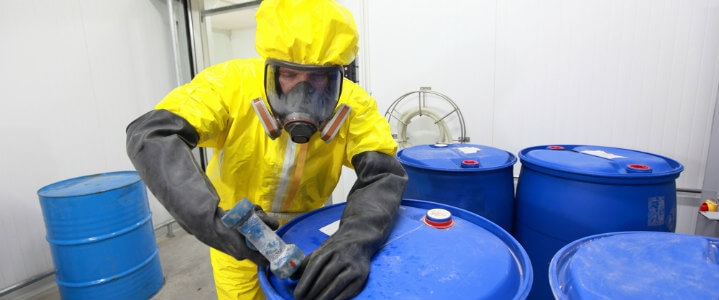Industries have long grappled with preventing unexpected releases of hazardous chemicals that can lead to disasters impacting the environment, employee safety, and public health. Real incidents, like the propylene gas explosion in Houston, underscore the urgency. To address this, government mandates necessitate businesses to adhere to strict guidelines for hazard control and risk mitigation.
What Is Process Safety Management (PSM)?
Process safety management (PSM) is a rule set by OSHA to help companies avoid mishandling or releasing highly hazardous chemicals (HHCs). PSM includes various requirements related to the handling, using, moving, storing, or manufacturing of these harmful chemicals.
OSHA PSM Standard
To keep workplaces safe and healthy, OSHA introduced the Process Safety Management of Highly Hazardous Chemicals standard. This standard outlines rules for managing processes involving extremely dangerous chemicals. These measures aim to avoid and reduce the risk of major releases of toxic, flammable, reactive, or explosive chemicals that could lead to fire or explosion hazards.

Does OSHA PSM Apply to Your Facility?
The PSM standard applies to industries that use highly hazardous chemicals, including by not limited to:
- Manufacturing industries (especially those pertaining to chemicals, fabricated metal products, and transportation equipment)
- Construction industries
- Electric, gas, and sanitary services
- Farm product warehousing
- Natural gas liquids
- Pyrotechnics and explosives manufacturers
- Wholesale trade
OSHA PSM requirements apply to companies that deal with more than 130 specific reactive and toxic chemicals in listed quantities, as well as flammable gases and liquids in quantities of 10,000 pounds or more.
Exceptions to OSHA PSM Applicability
The PSM standard does not apply to:
- Retail facilities
- Oil or gas well drilling or servicing operations
- Normally unoccupied remote facilities
Is Following the PSM OSHA Standard Legally Required?
The Clean Air Act Amendments (CAAA) of 1990 make the OSHA PSM program a legal requirement to prevent accidental releases of highly hazardous chemicals. Section 304 mandates OSHA to enforce a chemical safety standard, and the CAAA lists 14 process safety elements that employers must meet under the OSHA PSM standard.
Find out more about OSHA violations and fines for non-compliance.
14 Elements of a Process Safety Management Program
OSHA requests that employers have a process safety management system in place that follows these 14 rules and practices:
- Process Safety Information
- Process Hazard Analysis
- Operating Procedure
- Employee Participation
- Process Safety Management Training
- Contractor Training
- Pre-Startup Safety Review
- Mechanical Integrity
- Hot Work Permits
- Management of Change Process
- Incident Investigation/Accident Investigation
- Emergency Planning and Emergency Response
- Safety Compliance Audits
- Trade Secret Protection
Learn more about each of the different OSHA process safety management elements below.
1. Process Safety Information
Before conducting a process hazard analysis, OSHA mandates employers to create a compilation of written PSM safety topics. This aids both employers and employees in comprehending the potential hazards associated with working with highly hazardous chemicals.
Information regarding the highly hazardous chemicals in a process must consist of the following:
- Permissible exposure limits
- Toxicity
- Reactivity data
- Corrosivity data
- Physical data
- Thermal and chemical stability data
- Hazardous effects of inadvertent mixing of different materials
Information regarding the technology of a process must include the following:
- Process chemistry
- Maximum intended inventory
- A block flow or simplified process flow diagram
- Safe upper and lower limits for items such as flows, pressures, temperatures or compositions
- An evaluation of the consequences of deviations, particularly those affecting employees’ health and safety
2. Process Hazard Analysis
Process hazard analyses (PHAs) are designed to identify, evaluate, and control the hazards of processes involving extremely hazardous chemicals. Employers are required to adhere to one or more of the following methods in order to determine and evaluate the hazards involved in the process:
- What-if
- Checklist
- What-if/checklist
- Fault tree analysis
- Failure mode and effects analysis (FMEA)
- Hazard and operability study (HAZOP)
- Appropriate equivalent methodology
PHA’s must be updated every 5 years and retained for the life of the process. Consider contacting safety risk management consultants if you don’t think you can fully address these requirements on your own.
Learn more about the hierarchy of hazard control and how to perform a job safety analysis today.
3. Operating Procedure
Employers must maintain up-to-date written operating procedures for all covered processes, providing clear instructions that highlight hazards, health considerations, operating limitations, safety practices, and special circumstances. These procedures should be easily accessible to employees involved in the processes.

4. Employee Participation
OSHA mandates employers to consult with employees and representatives in developing process hazard analyses and other process management elements. Employers must grant access to process hazard analyses and relevant information to both worksite employees and contractor employees.
Learn how safety incentive programs can improve employee participation in workplace safety practices.
5. Process Safety Management Training
OSHA mandates training for employees operating covered processes, focusing on safety and health hazards, emergency operations, and best work practices. Initial OSHA PSM training must precede the assignment, with refresher training required every three years.
Safety By Design offers OSHA-aligned safety training in Houston to enhance the compliance and safety of your workplace.
6. Contractor Training
OSHA mandates contract employers to inform and train their employees on safe job performance. Contract employers must ensure their employees are trained, aware of process hazards, understand emergency action plans, are familiar with facility safety rules, and promptly report any hazards. This includes contract employees engaged in maintenance, repair, turnaround, renovation, or specialty work on or near covered processes.
7. Pre-Startup Safety Review
OSHA mandates a safety review for modified work sites and new facilities for the following reasons:
- To verify that equipment and construction are in accordance with design specifications
- To confirm that proper safety, maintenance, operating and emergency procedures are in place
- To assure that process operator training has been successfully completed
Learn about the Houston safety audit services offered by Safety By Design today!
8. Mechanical Integrity
OSHA requires on-site employers to develop and implement written procedures regarding the ongoing integrity of critical process equipment in the workplace. This ensures all equipment is properly designed, installed, and operating.
These PSM requirements apply to the following components and equipment:
- Piping systems (including components, valves)
- Pressure vessels and storage tanks
- Relief and vent systems and devices
- Controls (monitoring devices, alarms, sensors, interlocks)
- Emergency shutdown systems
- Pumps
9. Hot Work Permits
A permit must be kept on file for operations conducted on or near covered processes. The hot work permit must prove that fire prevention requirements were met prior to the beginning of operations. In addition, the permit must specify authorized work dates and location details.
See how fire watch training and welding safety requirements are crafted to protect your workers while performing hot work.
10. Management of Change Process
Written procedures are essential for managing changes to process chemicals, equipment, technology, procedures, and facility processes. Both worksite employers and contract employers must train and inform employees about changes before start-up, and these procedures should be regularly updated as needed.
This management of change (MOC) process must confirm that the following considerations are addressed:
- The change’s impact on employee safety and health
- The technical basis for a proposed change
- Modifications to current operating procedures
- Authorization requirements for a proposed change
- The necessary time period for a change
11. Incident Investigation/Accident Investigation
Employers must promptly investigate all workplace incidents with the potential for catastrophic accidents, conducting the analysis within 48 hours. A proficient investigation team should assess findings, produce a report for review by operating personnel, and retain all reports on file for a minimum of 5 years.
Check out this article to learn how to do OSHA incident and accident investigations.
12. Emergency Planning and Emergency Response
OSHA requires employers to have an emergency action plan and training for employees. In the event of an emergency, the entire plant should be prepared to handle hazardous chemical releases as well as follow other OSHA provisions.
13. Safety Compliance Audits
Employers are required to conduct a process safety management audit at least once every three years. These audits will confirm that the practices and procedures developed under the standard are satisfactory and are being followed.
A report must be made, documenting any deficiencies or corrections. Employers must keep the two most recent OSHA PSM audit reports on file. Safety By Design safety compliance services provide the peace of mind that you want when dealing with OSHA requirements.
14. Trade Secret Protection
Employers must comply with PSM by making all necessary information available to the following employees and representatives:
- Those performing compliance audits
- Those performing incident investigations
- Those developing process hazard analysis
- Those responsible for emergency planning and response
- Those compiling the process safety information
- Those developing operating procedures
PSM does not prevent employers from requiring employees to enter into confidentiality agreements to prevent the disclosure of trade secrets.

How to Get Help with Process Safety Compliance
Businesses frequently turn to third-party safety consulting firms for assistance with process safety compliance. These firms, staffed with qualified safety experts, are ready to address all your training and educational needs, regardless of your industry.
Safety Management Services
Safety management services are meticulously designed to meet businesses’ industrial and construction safety needs. Common services offered by safety consulting firms include:
- Safety Audit Services
- Safety Administrative Review Services
- Safety Compliance Services
- Training and Education Programs
OSHA-Aligned Training
Specialized OSHA training courses cover comprehensive educational requirements for hazardous work environments, ensuring employees are well-prepared to handle accidents in these conditions. The following are OSHA-compliant training services:
- Specialized OSHA Training Courses
- General Safety Training Courses
- Construction Safety Training Courses
- Train the Trainer Courses
Regular Safety Audits and Inspections
Safety audits and inspections aim to align employee activities with effective safety processes, enhance workplace safety, and ensure compliance with safety requirements per local, state, and federal guidelines. Elements of safety audits can include:
- Management Leadership and Employee Participation
- Workplace Analysis
- Accident and Record Analysis
- Hazard Prevention and Control
- Emergency Response
- Safety and Health Training
Learn more about what OSHA looks for in an inspection.
Get Help from a Trusted Safety Consultant in Texas
Process safety management standards are not something OSHA takes lightly. Luckily, you don’t have to face compliance challenges on your own. Partnering with a safety company — like Safety by Design, a top safety consulting firm in Texas — offers the resources needed to control, manage, and eliminate occupational safety and health hazards, ensuring employee safety and smooth operations.
Contact us today for help with meeting all your OSHA compliance and training needs.



